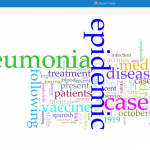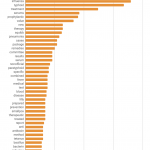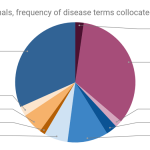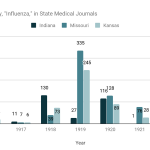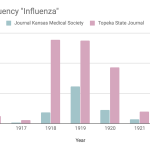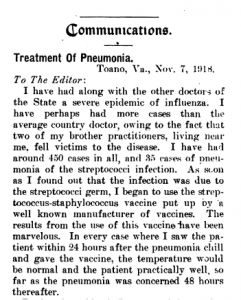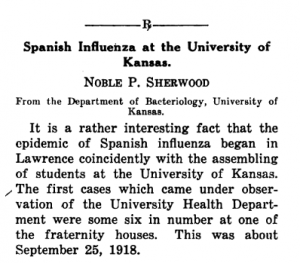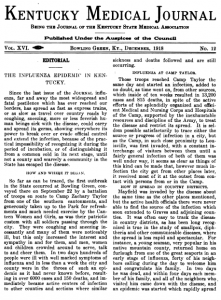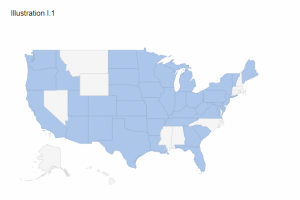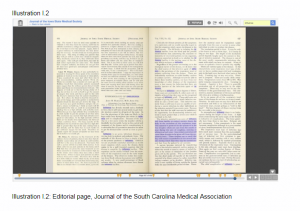~This is the fourth of four guest posts from a class taught by Tom Ewing at Virginia Tech in fall 2017. Read the other parts here: I, II, III. We are grateful to Professor Ewing and his students for sharing their wonderful work with us and allowing us to share it with our readers.
On October 2, 1918, the city of Boston recorded 188 deaths from influenza, the highest daily toll during the epidemic. [1] Just one day later, in an October 3 editorial, the Boston Medical and Surgical Journal conceded “the situation has become serious.” [2]
The Spanish influenza in 1918 challenged medical experts and public health officials because the scope and severity of the disease exceeded both their expectations for an outbreak and the capacities of available diagnostic, preventive, and treatment measures. This paper examines the response to the epidemic in the New England Journal of Medicine (then called the Boston Medical and Surgical Journal, hereafter BMSJ) from the first reports in late September through the peak death totals in October and ending with the abating epidemic in December 1918. This review is particularly timely now, as the centennial observation of the 1918 flu serves as a reminder of how historical analogies can and should shape epidemiological analysis and health policies. A careful analysis of this journal reveals a growing awareness of the severity of the epidemic, along with consistent efforts to underestimate the danger and make optimistic predictions of improving health conditions.
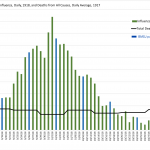
Figure 1: Deaths from Influenza, Boston, September – November 1918
The human toll of the epidemic confirms its unprecedented impact. The daily account of deaths due to influenza in Boston (Figures 1 and 2) clearly identifies the first week of October as the peak of the epidemic. A keyword search for “influenza” (Figure 3) and a term frequency chart (Figure 4) both indicate that early October is also when this journal first began reporting on the influenza epidemic. Comparing the daily toll of influenza deaths during the 1918 epidemic deaths from all causes in the fall of 1917 confirms the remarkable costs of this epidemic. [3] Boston’s 3,421 deaths from influenza in fall 1918 were just a fraction of the estimated 15,000 deaths in Massachusetts, 675,000 deaths in the United States, and 50-100 million deaths worldwide during the epidemic. [4]
The first substantive reporting appeared in the BMSJ on September 19, 1918 in “Medical Notes,” which stated that an “epidemic of influenza prevails” with 350 cases among sailors at the Commonwealth Pier. [5] This article quoted a September 5 statement from Dr. John S. Hitchcock, director of Department of Health’s division of communicable diseases, who combined reassurances about limited dangers with confident endorsements of preventive measures:
Unless precautions are taken, the disease in all probability will spread to the civilian population of the city. The malady appears to be in the nature of old-fashioned grip. No deaths have occurred. The naval medical authorities who have the matter in charge are doing everything possible to control the outbreak. With a focus of infection of this size, it seems probable that the disease will escape into the civil community in spite of all efforts at control. People should be reminded that under these conditions, persons with coughs and colds are not choice companions, and that a good doctor is a friend.
The assertion that “no deaths have occurred” may have been true on September 5, but was certainly not true when the
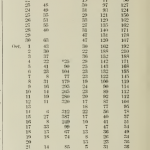
Figure 2: Influenza and Pneumonia Cases and Deaths in Boston, Table printed in Boston Medical and Surgical Journal, Vol. 179, No. 22, November 29, 1918, p. 688
BMSJ published the statement two weeks later, as the number of deaths had increased to almost fifty each day.
One week later, a September 26 editorial discussed the epidemic as a serious threat for the first time, yet the tone remains understated, with little evidence of a sense of alarm:
Unfortunately, the number of cases has increased, and the epidemic has now reached important proportions. Although every possible precaution has been taken, the disease has been spreading, especially in Navy cantonments. Furthermore, it has reached the civilian population and has invaded the schools, although not yet to a serious extent. [6]
The editorial explained how influenza was transmitted by droplets spread from person to person, recommended measures for controlling coughing and spitting, advised healthy persons to avoid crowds and sick people to stay home, and raised concerns about securing enough doctors and nurses. Public education campaigns were recommended, as advised by Surgeon General Rupert Blue: “The present outbreak may be controlled to more or less extent only by intelligent action on the part of the public.”
“Progress of Influenza Epidemic,” an editorial published October 3, included the statement, “the situation has become serious,” cited above:
The epidemic of so-called “Spanish” influenza is still spreading in Boston and in the neighboring districts and towns, Unfortunately, pneumonia has developed in many cases and the mortality list is at present higher than at any previous period since the outbreak of the epidemic. Although every possible precaution is being exercised, the situation has become serious. [7]
While acknowledging the growing toll, the editorial also made the reassuring, yet clearly baseless, claims that the “death rate remains normal although the number of cases has increased.”
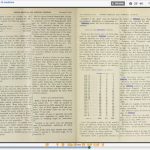
Figure 3: Search results, “Influenza,” Boston Medical and Surgical Journal, Vol. 179, July -Dec 1918, from Internet Archive
The October 10 issue of BMSJ, oddly, contains only one article specifically on influenza, a correction requested by a physician misquoted the previous week. [8] This issue did print death reports for the week ending September 28, 1918, indicating that 992 deaths from all causes represented an increase of more than 400% over the same week in 1917. [9] Even as the death toll reached unprecedented levels, however, the journal did not provide any meaningful explanation of why deaths had more than quadrupled since the previous year.
Two subsequent issues, October 17 and 24, by contrast, had numerous articles about the epidemic, including editorials, detailed accounts of specific cities, camps, and states, and statistics about cases and deaths. For the first time, the October 17 editorial acknowledged the actual severity of current conditions: “The epidemic of influenza-pneumonia, which has prevailed in Boston and surrounding districts for over two weeks, is still maintaining unprecedented strength.” [10] The editorial referred to “drastic measures” taken to “stamp out the epidemic,” including closing schools, bowling alleys, bars, and soda fountains, prohibiting public meetings, ordering churches not to hold services, regulating hours of businesses to prevent crowding, and cancelling public events. Yet these detailed accounts of public health measures were accompanied by declarations that “more encouraging conditions” were resulting in “a gratifying decrease in the number of deaths.”
“Notes on the Influenza Epidemic” in the October 17 issue included a daily list of 2,606 influenza deaths and 662 pneumonia deaths from September 14 to October 11. [11] This detailed list was prefaced with the neutral statement: “The Boston death record is as follows,” without any indication of the unprecedented toll. Detailed accounts of the epidemic elsewhere in the United States, including cases and deaths in military camps and major cities, were framed by a remarkable balance of concerns about the scope of the epidemic and reassurances that the danger was diminishing: “There is at present time very little abatement in the Spanish influenza epidemic, but stringent measures are being taken by every town and city in Massachusetts and elsewhere.” The article’s final paragraph illustrates how acknowledging real costs could be offset by confidence in policy measures: “Brockton’s latest list shows 100 per cent increase in the number of deaths, though the board gave the opinion that the situation is now well in hand with the ample number of doctors and nurses on hand.”
One week later, “The Waning Influenza Epidemic” continued to report worsening national conditions while
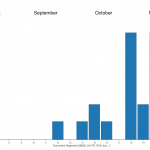
Figure 4: Term Frequency, Boston Medical and Surgical Journal, Vol. 179, July – December 1918, created using Voyant tool for text visualization
highlighting regional improvements: “With the bright, clear days of the past week, the influenza-pneumonia epidemic in the Eastern section has shown a gratifying decrease in the number of new cases as well as in the death rate. But while conditions are improving here, the influenza now has spread to practically every part of the country.” [12] An optimistic tone dominated reports on local conditions where health officials had “the influenza under control” and reported “a return to virtually normal conditions.” Most encouragingly, this editorial called attention to lessons learned by state officials: “Fresh air and sunshine are the most helpful aids…in the treatment of the influenza and the Massachusetts department desires to help all the other States as much as possible.”
“Notes on the Influenza Epidemic,” from the October 24 issue, amplified this optimism by declaring that “the epidemic is under control” in Worcester, “the influenza situation has improved decidedly” in Lawrence, the “influenza-pneumonia epidemic is on the wane” in Plymouth, conditions were “getting decidedly better” in Milford where “the high water mark” of deaths “is believed to have been reached,” and “the general situation is improving” in Newburyport. [13] Only rarely did more negative reports appear, such as the admission that the “epidemic is at its height [in Westfield] and no relief is in sight,” the “epidemic has broken out anew” in Fitchburg, or a Worcester cemetery could not schedule funerals because grave-diggers were so far behind.
From this point forward, the editorial tone became increasingly triumphant, even as articles documented the actual toll. The October 31 issue proclaimed “the crest of the epidemic has passed” in Boston, with only a brief recognition that 2,600 deaths “despite the best medical effort to prevent them” indicated “that the reports have not been exaggerated and impresses the seriousness of this disease to the health of the community.” [14] The November 7 issue reported increasing cases across the United States and world, yet also stated: “There is every indication now that the epidemic is disappearing even more rapidly than was expected,” [15] while the November 14 issue proclaimed: “The Spanish influenza is on the wane in New England and surroundings.” [16] In the November 21 issue, “Medical Notes” stated that cases in army and navy facilities near Boston had decreased to single digits, while offering “unstinted praise” for “those who aided in the fight against the recent grip epidemic.” [17] The most significant information contained in the November 28 issue, as discussed above, was the record of daily cases and death, yet this remarkable statistical report lacked any commentary on the unprecedented number of victims. [18]
“Great Mortality of Influenza Epidemic,” published on December 12, provides hard data that undercuts the consistently optimistic tone of earlier editorials. [19] From September 8 to November 9, American cities reported 83,306 deaths, of which 78,000 were reliably attributed to the epidemic, which “ravaged the country generally from coast to coast,” causing significantly more deaths than losses in the American Expeditionary Forces. The December 26 issue included this blunt statement from state Health Commissioner Eugene R. Kelley:
This epidemic has been a most serious one. It has killed an appalling number of our people and it has directly and indirectly caused the expenditure or loss of large amounts of money and has temporarily halted the progress of many industries. [20]
While these two reports offered direct evidence of the epidemic’s toll, it is perhaps significant that both were republished from other sources, without editorial commentary from this journal.
A review of four months of reporting on the Spanish influenza demonstrates a trajectory of growing awareness, deepening concern, and policy recommendations, always balanced by optimism, confidence, and eventually triumph. One lesson to be learned from the 1918 influenza epidemic is for medical professionals to ensure that accurate, timely, and realistic information is not distorted, delayed, or diluted by excessive confidence in the efficacy of health policies. In fact, the published statistical evidence makes it possible to follow the 1918 epidemic’s devastating trajectory in the pages of this journal. A close reading clearly indicates, however, that at every stage, from the first cases through the final calculations, these same reports expressed confidence that the medical establishment would protect the health of the population. By the end of the year, the journal could claim victory, but the actual human costs were clearly evident in the toll of deaths that filled these same pages.
Footnotes
- “Influenza and Pneumonia in Boston,” The Boston Medical and Surgical Journal, Vol. 179, No. 22, November 28, 1918, p. 688. Full text versions of this volume are available from the Internet Archive (link), Google Books (link) and the Hathi Trust library (link).
- “Progress of Influenza Epidemic,” The Boston Medical and Surgical Journal, Vol. 179, No. 14, October 3, 1918, p. 457.
- The numbers come from weekly reports, which usually included total deaths for the same week in the previous year.
- Data for Boston and Massachusetts is for the final months of 1918. Data for the United States and the world covers a broader period of time, from summer 1918 to summer 1920. “Mortality of Influenza in Massachusetts,” The Boston Medical and Surgical Journal, Vol. 179, No. 26, December 26, 1918, p. 808.
- “Medical Notes,” Boston Medical and Surgical Journal, Vol. 179, No. 14, September 19, 1918, p. 408.
- “The Epidemic of Influenza,” Boston Medical and Surgical Journal, Vol. 179, No. 15, September 26, 1918, pp. 430-434.
- “Progress of Influenza Epidemic,” p. 457.
- “The Grip Situation: A Correction,” The Boston Medical and Surgical Journal, Vol. 179, No. 15, October 10, 1918, p. 492.
- “Boston and Massachusetts,” The Boston Medical and Surgical Journal, Vol. 179, No. 15, October 10, 1918, p. 493.
- “Further Developments in the Progress of the Influenza Epidemic,” The Boston Medical and Surgical Journal, Vol. 179, No. 16, October 17, 1918, pp. 511-513.
- “Notes on the Influenza Epidemic,” The Boston Medical and Surgical Journal, Vol. 179, No. 16, October 17, 1918, pp. 519-520.
- “The Waning Influenza Epidemic,” The Boston Medical and Surgical Journal, Vol. 179, No. 17, October 24, 1918, pp. 538-540.
- “Notes on Influenza Epidemic,” The Boston Medical and Surgical Journal, Vol. 179, No. 18, October 24, 1918, pp. 546-549.
- “Medical Notes,” The Boston Medical and Surgical Journal, Vol. 179, No. 18, October 31, 1918, pp. 571-575.
- “Progress of the Influenza Epidemic,” The Boston Medical and Surgical Journal, Vol. 179, No. 19, November 7, 1918, pp. 603-605.
- “Progress of the Spanish Influenza Epidemic,” The Boston Medical and Surgical Journal, Vol. 179, No. 20, November 14, 1918, pp. 633-644.
- “Progress of the Influenza Epidemic,” The Boston Medical and Surgical Journal, Vol. 179, No. 21, November 21, 1918, p. 659.
- “Medical Notes,” The Boston Medical and Surgical Journal, Vol. 179, No. 22, November 28, 1918, pp. 687-689.
- “Great Mortality of Influenza Epidemic,” The Boston Medical and Surgical Journal, Vol. 179, No. 24, December 12, 1918, pp. 743-744.
- “Delay in Reporting Cases of Influenza,” The Boston Medical and Surgical Journal, Vol. 179, No. 26, December 26, 1918, pp. 807-808.












